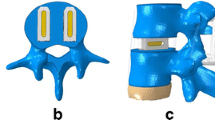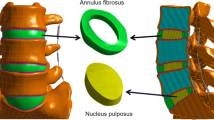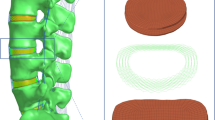Abstract
Introduction
When an interbody cage is inserted into a human being’s lumbar spine, not only the design, but also the material used is considerably crucial, particularly when minimally invasive lumbar fusion (MILIF) approaches are considered. The purpose of this study was to design a multi-function cage (either for MILIF or open lumbar interbody fusion) and also to evaluate the strength of the design based on a finite-element model analysis.
Method
Three-dimensional finite-element models that were instrumental in the reproduction of post-operative conditions under which different cages, such as assembled lumbar interbody fusion cages (ALIFC) and the separated ones, could be examined and traced after implantation were developed. Simulations were run to realize various loading conditions including axial compression, flexion, extension, lateral bending and rotation under a constant compressive preload. Meanwhile, the evaluation results derived from FEMs data focused on endplate stress distribution, peak stress of von Mises and stress of cage. Stress distributions on the bone surface were evaluated and discussed as well.
Results
The consequences of cage insertion, high strains and stresses, were concentrated in the areas where the cage and endplate were in contact with each other. Simultaneously, contact stresses around the implants seemed to be concentrated around the periphery of the device. After implantation of ALIFC, the stiffness of the new cages was similar to that of traditional cages in an assemble condition, according to the biomechanical data dealing with FEM. Once a separated cage was in the place of an assembled cage, the stresses would get symmetrically distributed in the lateral areas of the endplate and decrease significantly at the center where the separated cage was not in contact with the endplate. The stress of the cage was going to be high once being rotating; most significant difference of stresses distribution due to the alternative choice has been found in the state of rotation. On comparison of peak von Mises stresses on the endplates in the new cage, the stresses were symmetrically distributed in the lateral areas of the endplate when a separated cage was used in place of an assembled cage.
Conclusion
The new cage was more advantages with regard to endplate stress distribution, peak stress of von Mises and stress of cage than the assembled state. ALIFC can provide sufficient primary stability for lumbar intervertebral fusion and the new cage may be regarded as a suitable device for load-bearing implantation.




Similar content being viewed by others
References
Kanayama M, Cunningham BW, Haggerty CJ et al (2000) In vitro biomechanical investigation of the stability and stress-shielding effect of lumbar interbody fusion devices. J Neurosurg 93(Suppl 2):259–265
Fessler RG (2002) Minimally invasive spine surgery. Neurosurgery 51(Suppl 5):Siii–Siv
Khoo LT, Palmer S, Laich DT et al (2002) Minimally invasive percutaneous posterior lumbar interbody fusion. Neurosurgery 51(Suppl 5):S166–S171
Lieberman IH, Willsher PC, Litwin DE et al (2000) Transperitoneal laparoscopic exposure for lumbar interbody fusion. Spine 25:509–514 discussion 515
Zdeblick TA, David SM (2000) A prospective comparison of surgical approach for anterior L4–L5 fusion: laparoscopic versus mini anterior lumbar interbody fusion. Spine 25:2682–2687
Polikeit A, Ferguson S, Nolte LP, Orr T (2002) Factors influencing stresses in the lumbar spine after the insertion of intervertebral cages: finite-element analysis. Eur Spine J. doi:10.1007/s00586-002-0505-8
Kim Y (2001) Prediction of mechanical behaviors at interfaces between bone and two interbody cages of lumbar spine segment. Spine 26(13):1437–1442
Kim Y, Vanderby R (2000) Finite-element analysis of interbody cages in a human lumbar spine. Comput Methods Biomech Biomed Eng 3:257–272
Grant JP, Oxland TR, Dvorak MF (2001) Mapping the structural properties of the lumbosacral vertebral endplates. Spine 26(8):889–896
Steffen T, Tsantrizos A, Aebi M (2000) Effect of implant design and endplate preparation on the compressive strength of interbody fusion constructs. Spine 25(9):1077–1084
Lowe TG, Hashim S, Wilson LA et al (2004) A biomechanical study of regional endplate strength and cage morphology as it relates to structural interbody support. Spine 29(21):2389–2394
Pitzen T, Geisles F, Matthis D et al (2002) A finite-element model for predicting the biomechanical behaviour of the human lumbar spine. Control Eng Pract 10:83–90
Grant JP, Oxland TR, Dvorak MF et al (2002) The effects of bone density and disc degeneration on the structural property distributions in the lower lumbar vertebral endplates. J Orthop Res 20:1115–1120
Bailey CS (2003) Local strength and regional bone mineral density profiles of the thoracolumbar endplate [MSc (Surg) thesis]. University of British Columbia, British Columbia, Canada
Polikeit A, Ferguson SJ, Nolte LP et al (2003) Factors influencing stresses in the lumbar spine after the insertion of intervertebral cages: finite-element analysis. Eur Spine J 12:413–420
Labrom RD (2002) The effect of cage positioning on lumbosacral vertebral endplate failure in compression [MSc (Surg) thesis]. University of British Columbia, British Columbia
Krammer M, Dietl R, Lumenta CB et al (2001) Resistance of the lumbar spine against axial compression forces after implantation of three different posterior lumbar interbody cages. Acta Neurochir (Wien) 143:1217–1222
Murakami H, Boden SD, Hutton WC (2001) Anterior lumbar interbody fusion using a barbell-shaped cage: a biomechanical comparison. J Spinal Disord 14:385–392
Tsantrizos A, Baramki HG, Zeidman S et al (2000) Segmental stability and compressive strength of posterior lumbar interbody fusion implants. Spine 25:1899–1907
Chen CS, Cheng CK, Liu CL et al (2001) Stress analysis of the disc adjacent to interbody fusion in lumbar spine. Med Eng Phys 23:483–491
Chen CS, Cheng CK, Liu CL (2002) A biomechanical comparison of posterolateral fusion and posterior fusion in the lumbar spine. J Spinal Disord Tech 15:53–63
Chen CS, Feng CK, Cheng CK et al (2005) Biomechanical analysis of the disc adjacent to posterolateral fusion with laminectomy in lumbar spine. J Spinal Disord Tech 18:58–65
Lee CK, Kim YE, Lee CS et al (2000) Impact response of the intervertebral disc in a finite-element model. Spine 25:2431–2439
Qiu TX, Teo EC, Lee KK et al (2003) Validation of T10–T11 finite-element model and determination of instantaneous axes of rotations in three anatomical planes. Spine 28:2694–2699
Niebur GL, Feldstein MJ, Yuen JC, Chen TJ, Keaveny TM (2000) High-resolution finite-element models with tissue strength asymmetry accurately predict failure of trabecular bone. J Biomech 33:1575–1583
Bayraktar HH, Keaveny TM (2004) Mechanism of uniformity of yield strains for trabecular bone. J Biomech 37:1671–1678
Yeh OC, Keaveny TM (2001) Relative role of microdamage and microfracture in the mechanical behaviour of trabecular bone. J Orthop Res 19:1001–1007
Stolken JS, Kinney JH (2003) On the importance of geometric nonlinearity in finite-element simulations of trabecular bone failure. Bone 33:494–504
Fantigrossi A, Galbusera F, Raimondi MT et al (2007) Biomechanical analysis of cages for posterior lumbar interbody fusion. Med Eng Phys 29:101–109
Acknowledgment
The work is funded and supported by National Natural Science Funds of Chongqing (2007BB5060).
Conflict of interest statement
None.
Author information
Authors and Affiliations
Corresponding author
Rights and permissions
About this article
Cite this article
Ding, JY., Qian, S., Wan, L. et al. Design and finite-element evaluation of a versatile assembled lumbar interbody fusion cage. Arch Orthop Trauma Surg 130, 565–571 (2010). https://doi.org/10.1007/s00402-010-1055-x
Received:
Published:
Issue Date:
DOI: https://doi.org/10.1007/s00402-010-1055-x




